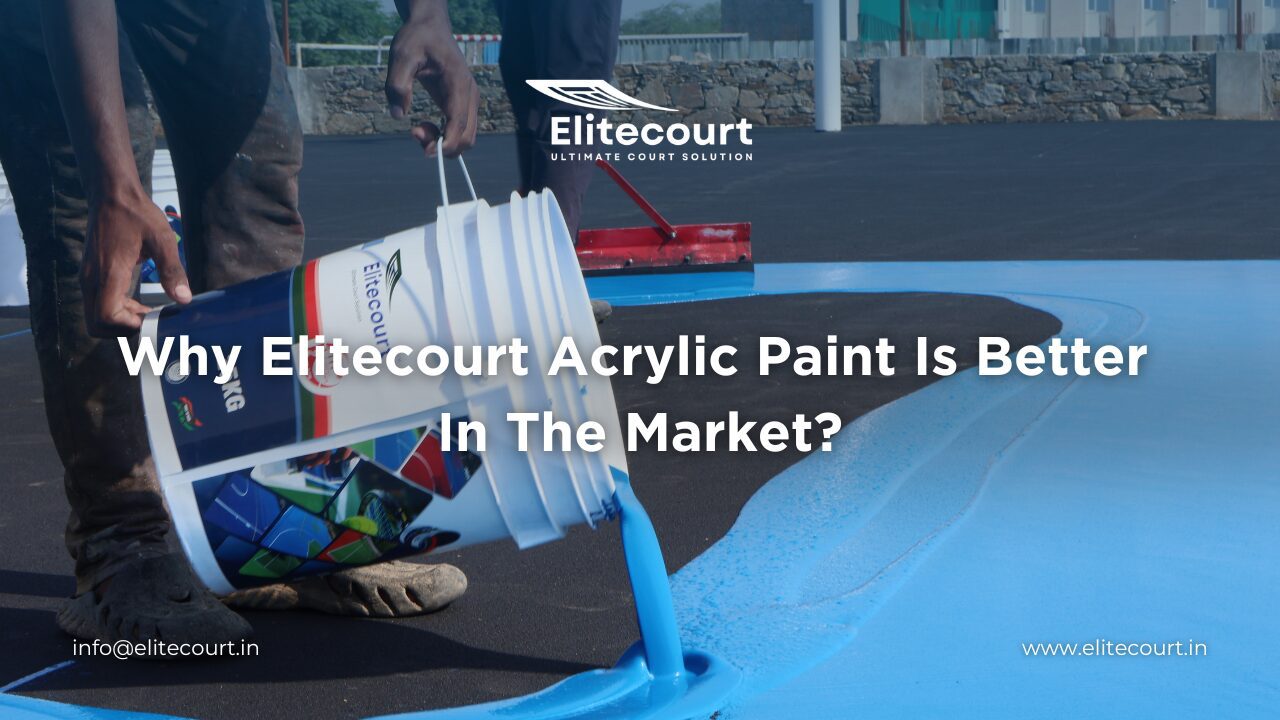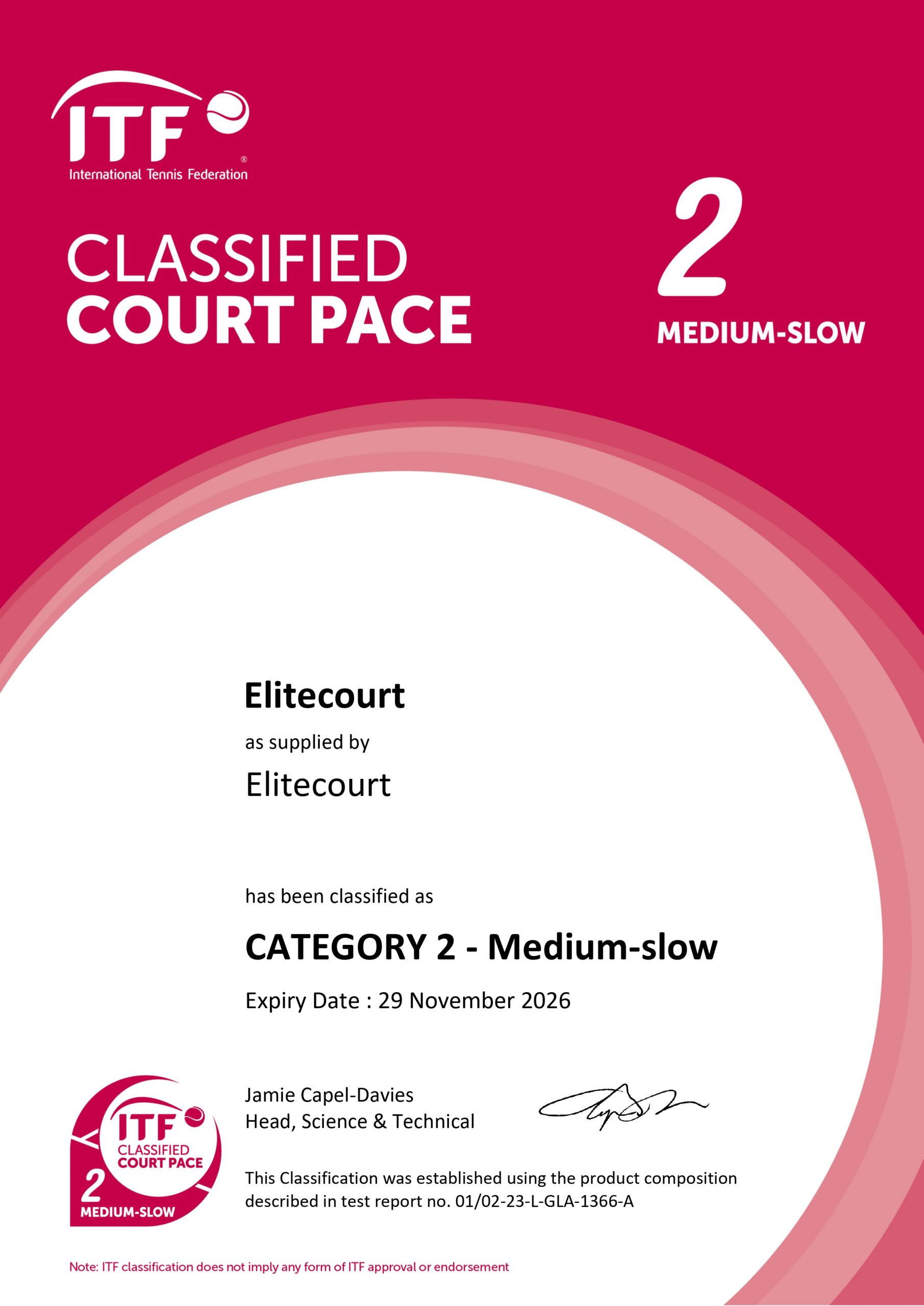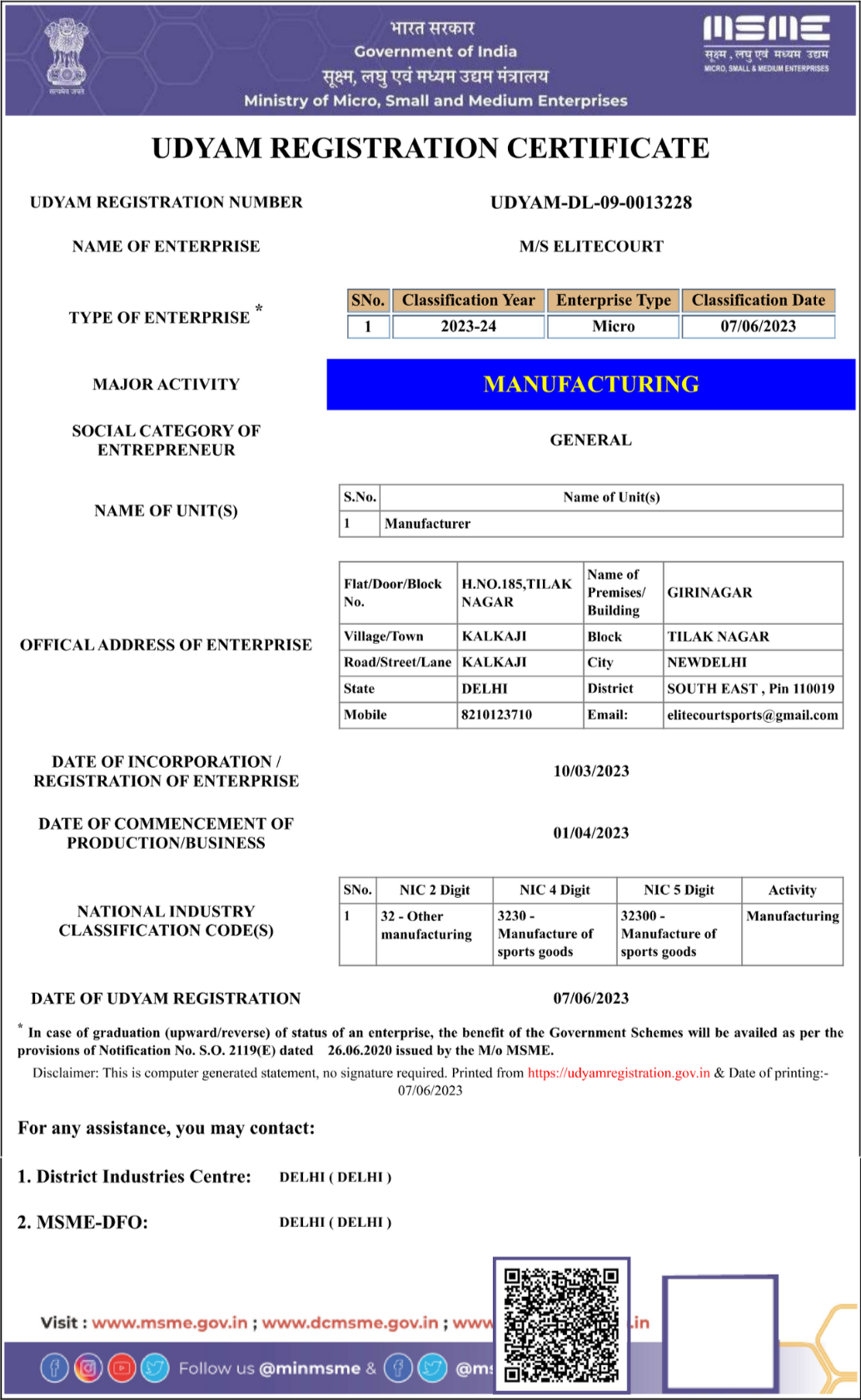What Is a Tennis Court Floor Made Of?
With years of expertise in crafting world-class synthetic acrylic sports flooring, Elitecourt stands as India’s most trusted name in professional sports surfaces. Renowned for innovation, quality, and reliability, we specialize in manufacturing high-performance materials that redefine durability and playability for modern tennis courts.

Table of Contents
Introduction: Understanding the Core of a Tennis Court Floor
Ever wondered what a tennis court floor is made of and why the surface feels so unique compared to other sports courts? The answer lies in the science of materials and the precision of design. A tennis court’s floor isn’t just a simple slab—it’s a multi-layered system engineered to deliver performance, safety, and longevity.
From the synthetic acrylic layers that determine ball bounce and speed to the carefully prepared sub-base that ensures stability, every component plays a critical role. The type of surface directly influences a player’s movement, reaction time, and even the overall gameplay. Whether it’s the hard, fast surface of the U.S. Open or the softer clay courts of Roland Garros, each court type begins with one vital foundation—its flooring material.
At Elitecourt, our focus lies in synthetic acrylic tennis court flooring, a globally preferred surface due to its weather resistance, low maintenance, and consistent playing characteristics. In this article, we’ll explore each element that makes up a tennis court floor, its material composition, how it affects performance, and why synthetic acrylic is the modern standard for professional and recreational courts alike.
The Anatomy of a Tennis Court Floor
A tennis court floor may appear simple on the surface, but beneath that smooth, vibrant layer lies a complex structure designed for endurance and precision. Let’s break down the main components that make up a standard tennis court flooring system:
- Subgrade (Base Layer) – The foundation of stability.
- Sub-base (Crushed Stone Layer) – Provides drainage and support.
- Asphalt or Concrete Base – The hard platform that defines court performance.
- Acrylic Resurfacer Layer – Smooths and seals the surface.
- Cushion Layers (optional) – Adds comfort and shock absorption.
- Acrylic Color Coating System – Provides texture, traction, and aesthetics.
- Line Markings – Painted with specialized acrylic paints for precision.
Each layer contributes to how the surface responds to play, and omitting or compromising on any step can impact the court’s longevity and quality.
Subgrade: The Foundation That Defines Durability
The subgrade is where it all begins. It’s essentially the compacted natural soil layer that supports every structure built above it. A well-prepared subgrade ensures the court remains level and stable for years, resisting the challenges of weather and time.
A properly graded and compacted subgrade prevents uneven settling, which could otherwise cause cracks or puddles on the court surface. This base must be engineered to allow proper drainage, ensuring rainwater doesn’t pool and affect playability.
Elitecourt emphasizes the importance of soil testing and moisture content analysis before any court construction begins. This ensures that when our synthetic acrylic coatings are applied, they rest on a foundation capable of enduring heavy use and environmental stresses without deterioration.
Sub-base: Strength and Drainage Beneath the Surface
Sitting above the subgrade is the sub-base, typically composed of crushed stone or gravel. This layer acts as a cushion that distributes loads evenly and facilitates drainage. The size and compaction of these stones are crucial — too loose, and the surface becomes unstable; too tight, and water fails to drain efficiently.
For tennis courts, drainage is non-negotiable. Without proper drainage, even the best acrylic coatings can blister, peel, or develop algae due to moisture retention. The sub-base ensures that rainwater or irrigation flows away swiftly, keeping the upper layers intact.
At Elitecourt, our material formulations are optimized for synthetic acrylic flooring systems that perform exceptionally well over stable, well-drained bases. The better the drainage and compaction, the longer the court’s lifespan.
Asphalt or Concrete Base: The Hard Platform
The asphalt or concrete base serves as the structural platform of the tennis court. This layer is responsible for defining the flatness, rigidity, and rebound quality of the surface.
Asphalt Base
An asphalt base is the more common choice due to its slight flexibility, which helps absorb minor ground movements. It’s ideal for outdoor courts as it handles temperature variations better.
Concrete Base
A concrete base, on the other hand, offers greater structural integrity and is preferred for indoor installations or areas with minimal temperature fluctuations. However, it requires expansion joints to prevent cracking.
Elitecourt’s synthetic acrylic coatings adhere seamlessly to both asphalt and concrete, ensuring a uniform texture and excellent bond strength for optimal play.
Transform Your Sports Facility Today!
Contact us for high-quality synthetic sports flooring material and elevate your space!
Acrylic Resurfacer: The Layer That Sets the Stage
Once the hard base is in place, a resurfacer layer is applied. This is a blend of acrylic latex, silica sand, and water, serving as a leveling compound that fills in minor surface imperfections. It ensures the subsequent layers adhere properly and deliver a consistent texture.
The resurfacer also acts as a barrier, preventing oils from asphalt or impurities from concrete from seeping into the top layers. This step is critical in achieving the seamless finish that players expect from a professional-grade court.
At Elitecourt, we engineer resurfacing materials to optimize grip, ball response, and UV resistance. A high-quality resurfacer doesn’t just prepare the surface—it extends the life and performance of the entire system.
Cushion Layers: Comfort and Player Safety
Cushion layers are optional but increasingly popular for professional and recreational courts. These are elastomeric acrylic compounds infused with fine rubber particles that add a shock-absorbing effect to the surface.
Think of it like adding a memory foam layer under a mattress—it doesn’t change the overall structure but makes every movement smoother and safer. Cushion systems reduce stress on joints and muscles, allowing players to train longer without fatigue.
Elitecourt’s synthetic acrylic cushioning systems are specifically formulated to provide optimal player comfort while maintaining performance standards. These layers are particularly beneficial for community courts, training facilities, and multi-sport complexes.
Acrylic Color Coating System: Beauty Meets Functionality
The final, most visible part of the tennis court floor is the acrylic color coating system. These coatings define not just the color and appearance but also the texture, traction, and pace of the court.
A typical color system includes:
- Acrylic color basecoat
- Textured color topcoat
- Anti-slip additives for grip and safety
Elitecourt manufactures UV-stable, fade-resistant color coatings that retain their vibrancy for years. The texture ensures controlled ball bounce while allowing players the perfect balance between grip and glide.
Expert Tip: The right surface texture can dramatically improve play performance. Too rough, and it slows the game. Too smooth, and it increases the risk of slips.
Line Markings: Precision That Defines the Game
Once the surface coatings are complete, the final step is applying line markings. These lines are painted using high-grade, non-slip acrylic paints that resist wear and fading. Precision in marking ensures fair play and proper visual contrast with the court color.
Elitecourt provides line marking solutions that complement the overall surface system, ensuring consistency in adhesion and color durability.
Synthetic Acrylic: The Preferred Tennis Court Material
So, what is a tennis court floor made of in most modern facilities? The answer—synthetic acrylic systems. They have become the gold standard across the world for both professional tournaments and recreational courts.
Here’s why:
- Durability: Withstands weather, UV, and heavy foot traffic.
- Performance: Offers predictable ball bounce and consistent play.
- Maintenance: Minimal upkeep compared to clay or grass courts.
- Aesthetics: Customizable colors that retain vibrancy over years.
- Safety: Anti-slip and shock-absorbent options available.
Elitecourt’s advanced synthetic acrylic formulations are designed to meet international sports flooring standards, ensuring every surface provides the perfect combination of performance and longevity.
Why Acrylic Surfaces Dominate Modern Tennis Courts
When you watch professional tournaments or community matches today, you’ll notice that most courts share one defining characteristic—the acrylic surface. But why has this material become the industry standard? The reasons go far beyond its appearance.
Acrylic flooring offers a balanced playing speed that suits a wide range of players—from beginners to elite professionals. Unlike clay or grass courts, which require frequent maintenance and are weather-sensitive, acrylic tennis courts maintain consistent performance year-round. They are designed to endure the heat, UV rays, and rainfall common in regions like India, where temperature fluctuations can be extreme.
One of the biggest advantages is customization. By adjusting the composition of acrylic coatings and cushion layers, manufacturers like Elitecourt can tailor the surface’s pace—creating slow, medium, or fast courts as required. This flexibility allows clubs, academies, and sports complexes to build courts that suit their specific training or competition needs.
Another remarkable benefit is color versatility. Acrylic coatings can be pigmented into a wide range of shades, from traditional green and blue to contemporary custom palettes. The result? Visually striking courts that maintain professional-grade traction and bounce characteristics.
In short, acrylic flooring delivers an unbeatable mix of performance, resilience, and beauty, making it the go-to choice for tennis facilities across the world.
The Science Behind Acrylic Coating Systems
Let’s dive a little deeper into what makes acrylic so special. At its core, acrylic is a thermoplastic polymer—a compound known for its flexibility, water resistance, and excellent bonding strength. When combined with silica sand and resins, it forms a durable, textured layer that ensures both grip and comfort underfoot.
Key Components of Acrylic Systems
- Acrylic Latex: Provides elasticity and UV resistance.
- Silica Sand: Adds texture and traction.
- Pigments: Ensure long-lasting, vibrant colors.
- Additives: Enhance drying time, flexibility, and adhesion.
This multi-layer chemistry allows Elitecourt to create flooring systems that balance durability with playability. Each coating cures to form a strong, water-impermeable film that adheres firmly to asphalt or concrete, protecting the surface beneath.
How It Affects Gameplay
Acrylic coatings influence ball bounce, spin, and player grip. A slightly textured surface ensures that balls respond predictably and that players maintain footing even during aggressive lateral movements. This scientific precision is what differentiates a professionally engineered tennis court from a basic painted surface.
Different Types of Tennis Court Surfaces
While the spotlight here is on synthetic acrylic courts, it’s essential to understand how they compare with other traditional surfaces. There are primarily four types of tennis court flooring materials, each with its unique characteristics:
| Surface Type | Composition | Play Speed | Maintenance | Common Use |
|---|---|---|---|---|
| Grass Courts | Natural grass on soil base | Fast | High | Elite tournaments (e.g., Wimbledon) |
| Clay Courts | Crushed stone, brick, or shale | Slow | High | European and South American clubs |
| Hard Courts (Acrylic) | Asphalt/concrete with acrylic coatings | Medium-Fast | Low | Global tournaments, schools, clubs |
| Carpet or Synthetic Turf | Textile or polymer surface | Medium | Moderate | Indoor or multi-sport facilities |
Acrylic hard courts stand out because they offer the most consistent, all-weather performance. They combine the fast pace of grass with the control of clay—without the constant maintenance those surfaces demand.
Elitecourt’s Role in Revolutionizing Tennis Flooring in India
As a leading manufacturer of synthetic acrylic sports flooring, Elitecourt has played a pivotal role in setting high-quality standards in India’s tennis infrastructure. Our materials are designed to perform under India’s diverse climatic conditions, from humid coastal regions to dry inland zones.
Elitecourt’s acrylic formulations undergo rigorous testing for adhesion, UV stability, and tensile strength. The result? A surface that looks pristine and performs exceptionally for years. We collaborate with sports infrastructure developers and contractors, supplying them with premium-quality acrylic materials to build world-class courts that rival international standards.
By focusing solely on manufacturing excellence, Elitecourt ensures that every layer—from resurfacer to color coating—meets the performance benchmarks required for competitive play. This commitment to precision and reliability has made Elitecourt a trusted partner for academies, sports clubs, and institutional projects across India.
Transform Your Sports Facility Today!
Contact us for high-quality synthetic sports flooring material and elevate your space!
Environmental and Performance Benefits of Acrylic Courts
Beyond playability and aesthetics, synthetic acrylic flooring also offers environmental and long-term performance benefits. Elitecourt’s materials are eco-conscious, free from harmful solvents and heavy metals, making them safer for both installers and the environment.
Environmental Advantages
- Low VOC emissions – Ensures a cleaner, safer installation process.
- Water-based formulation – Reduces the need for harsh chemicals.
- Long lifespan – Minimizes waste and resource consumption.
Performance Advantages
- UV and weather resistance – Withstands extreme sunlight and rain.
- Non-slip texture – Improves safety even in wet conditions.
- Color stability – Prevents fading and chalking over time.
- Easy maintenance – Regular sweeping and occasional washing are enough.
By manufacturing eco-friendly, high-performance acrylic systems, Elitecourt not only ensures long-lasting courts but also contributes toward sustainable sports infrastructure development in India.
How Weather Affects Tennis Court Flooring
Weather plays a huge role in the performance and longevity of any sports surface. That’s why material choice and formulation matter so much. In India, where temperatures can swing dramatically and monsoon seasons bring heavy rain, materials must withstand expansion, contraction, and moisture intrusion.
Acrylic surfaces excel in this regard. Their flexible polymer matrix expands and contracts without cracking, unlike rigid concrete or brittle coatings. Additionally, their UV-stable pigments resist fading even under intense sunlight. When paired with proper base preparation and drainage, Elitecourt’s acrylic systems ensure all-season reliability.
Elitecourt’s coatings are engineered with superior adhesion technology, ensuring that the layers bond strongly even in humid or saline environments. This makes them suitable for coastal installations where salt and moisture can damage inferior materials.
How Acrylic Flooring Enhances Player Performance
Performance in tennis isn’t just about skill—it’s about how the surface interacts with every movement. Acrylic flooring creates a consistent environment where players can rely on predictable ball bounce and traction.
Impact on Ball Behavior
The micro-texture of acrylic layers directly affects how the ball bounces and spins. Surfaces with slightly coarser textures offer higher friction, slowing down the ball slightly and allowing for longer rallies. Smoother finishes, on the other hand, promote a faster-paced game.
Impact on Player Movement
Acrylic coatings provide a fine balance between grip and glide, enabling quick sprints and safe stops. Cushion layers underneath can reduce joint strain, minimizing the risk of injuries—especially during long matches or intense training sessions.
Elitecourt’s systems are specifically designed to support athletic performance while minimizing fatigue. The result is a surface that players trust and enjoy, whether they’re practicing drills or competing in tournaments.
Installation Process of a Synthetic Acrylic Tennis Court
Even though Elitecourt specializes in manufacturing, understanding the installation sequence helps appreciate how materials come together to form a complete surface system.
- Site Preparation – Grading, compacting, and establishing proper drainage.
- Base Construction – Laying asphalt or concrete to precise levels.
- Resurfacer Application – Sealing and smoothing the base.
- Cushion System (if used) – Layering acrylic rubberized coatings.
- Acrylic Color Coats – Applying multiple coats for durability and appearance.
- Line Markings – Final precision painting with acrylic marking paints.
Each step requires attention to detail. The quality of materials, like those supplied by Elitecourt, directly determines how well the court performs and how long it lasts.
Maintenance Tips for Acrylic Tennis Courts
While acrylic surfaces are known for being low-maintenance, routine care goes a long way in keeping them at their best. Proper upkeep preserves surface texture, appearance, and playability.
Regular Maintenance Tips
- Sweep or blow debris off regularly to prevent abrasion.
- Wash periodically with mild detergent to remove dust or stains.
- Avoid standing water—check that drains and slopes remain effective.
- Inspect for cracks or surface damage annually and repair promptly.
- Use proper footwear to avoid scuffing or marking.
Expert Advice
“A tennis court performs only as well as it’s maintained. Using quality acrylic materials is half the equation—routine care completes it.” – Elitecourt Technical Team
By following these simple practices, facility owners can ensure that their Elitecourt acrylic surfaces continue to perform flawlessly for many years.
Acrylic vs. Other Synthetic Court Materials
When comparing flooring materials, synthetic acrylic outperforms most alternatives in both versatility and long-term stability.
| Feature | Acrylic Flooring | Polyurethane (PU) Flooring | PVC Flooring |
|---|---|---|---|
| Durability | Excellent | Good | Moderate |
| UV Resistance | High | Moderate | Low |
| Slip Resistance | Adjustable | Moderate | High |
| Maintenance | Low | Moderate | High |
| Outdoor Suitability | Excellent | Limited | Poor |
Acrylic coatings are uniquely formulated for outdoor use, making them ideal for India’s varied climate. They resist both heat and moisture without discoloring or deteriorating—something few other materials can match.
Industry Standards and Certifications
For any sports flooring material, compliance with international standards is key. Acrylic court coatings must meet specific benchmarks for surface hardness, friction coefficient, and ball rebound consistency.
Elitecourt’s products are manufactured in alignment with international tennis surface standards, ensuring that courts built with our materials meet the criteria for safe and professional play. For reference, the International Tennis Federation (ITF) sets the global classification standards for court surfaces.
By adhering to these benchmarks, Elitecourt ensures that every batch of flooring material delivers consistent, tournament-grade performance.
Why Choose Elitecourt for Synthetic Acrylic Flooring
Choosing the right manufacturer can make all the difference between a standard court and a world-class surface. Elitecourt stands apart due to:
- Proven quality and consistency in every batch.
- Customizable formulations for desired speed and comfort.
- Advanced UV and weather protection for Indian climates.
- Environmentally responsible production with water-based systems.
- Trusted partnerships with sports infrastructure developers nationwide.
Elitecourt’s mission is simple: to deliver exceptional synthetic acrylic flooring solutions that elevate every match, every movement, and every moment on the court.
Transform Your Sports Facility Today!
Contact us for high-quality synthetic sports flooring material and elevate your space!
Conclusion
A tennis court floor is more than just a playing surface—it’s a precision-engineered system built from layers that balance performance, comfort, and longevity. From the solid foundation beneath to the vibrant acrylic topcoat, every detail contributes to the player’s experience.
When you ask, what is a tennis court floor made of, the complete answer lies in understanding how materials like synthetic acrylic combine technology and artistry to create courts that inspire performance and endure the elements.
With Elitecourt’s expertise, innovation, and commitment to quality, India’s tennis infrastructure continues to rise to international standards—one acrylic layer at a time.
FAQs
The best material for most modern courts is synthetic acrylic. It offers exceptional durability, consistent play, and minimal maintenance, making it ideal for both professional and recreational use.
With proper maintenance, an Elitecourt acrylic surface can maintain its performance for many years before requiring resurfacing. The lifespan depends on environmental exposure and maintenance routines.
Yes, while acrylic courts are typically installed outdoors, they perform excellently indoors as well when applied over a properly prepared concrete base.
Elitecourt’s products are engineered for Indian climatic conditions, offering superior UV resistance, color stability, and player comfort while maintaining international performance standards.
Most acrylic courts benefit from resurfacing every few years, depending on usage and exposure. Regular cleaning and minor repairs can significantly extend the interval between resurfacing.








